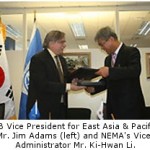 New Delhi – A new United Nations Development Programme (UNDP) film examines the shrinking glaciers of the Himalayas and the effects they have on the lives and livelihoods of people in Asia.
New Delhi – A new United Nations Development Programme (UNDP) film examines the shrinking glaciers of the Himalayas and the effects they have on the lives and livelihoods of people in Asia.
“Revealed: Himalayan Meltdown” screened in New Delhi on July 19 examines the human development impact of the glacial ice melt on communities in Bangladesh, Bhutan, China, India and Nepal. It shows the plight of the affected countries and the ways they are adapting, adjusting and preparing for tomorrow’s inevitable changes in the Himalayan glaciers.
Over 55,000 glaciers account for 40 percent of the earth’s fresh water and provide water to over two billion people. According to Shri Jairam Ramesh, Minister for Rural Development, Government of India, “The film portrays the threat posed by glacial melt and is a stark reminder of the challenge posed by global warming and climate change. This predicament unites the rural poor across nations and makes a powerful call for concerted action across political boundaries.’’
While developing countries are more vulnerable to the impacts of climate change, they are less able to afford to adapt to it. According to Ajay Chhibber, United Nations Assistant Secretary General, UNDP Assistant Administrator and Regional Director for Asia and the Pacific, ‘‘The challenge for developing countries is to adapt today to changing climate and prepare for an uncertain tomorrow.’’
‘‘This calls for robust knowledge that can feed into policy and action across national boundaries,’’ he added.
The film illustrates solutions, small and large, simple and technologically complex, for coping with a changing environment that can make the difference between survival and disappearance. It features innovative fog-catching in Nepal, man-made glaciers in India, views of life in the changing plateaus of China, and pioneering UNDP climate change adaptation projects in Bhutan and Bangladesh.
Technological advances from leading glaciologists, experts at the International Centre for Integrated Mountain Development (ICIMOD) and UNDP offer insights into what is in progress and what still needs to be done for countries to address the Himalayan ice melt.
According to Patrice Coeur-Bizot, United Nations Resident Coordinator and UNDP Resident Representative, India, ‘‘Melting glaciers will alter river flows causing both floods and water scarcity and influence the climate, monsoons and rainfall patterns. Community resilience and innovative local solutions will be crucial to adapting to the changing climate.’’
Recognizing the importance of simple actions that can help communities adapt to a changing climate, UNDP also acknowledged the contribution of Chhewang Norphel, Chief Project Officer, Leh Nutrition Project Housing Colony. Better known as the ‘‘Ice Man’’, Norphel has brought hope to thousands of farmers in the Ladakh region through his innovative idea of building artificial glaciers that store melting glacial water and help irrigate land in the region. Ajay Chhibber felicitated Norphel at the screening in New Delhi.
The film ‘Revealed: Himalayan Meltdown’ will be disseminated widely across schools and universities both in India and worldwide.
About UNDP
UNDP partners with people at all levels of society to help build nations that can withstand crisis, and drive and sustain the kind of growth that improves the quality of life for everyone. With offices in more than 160 countries and territories, we offer global perspective and local insight to help empower lives and build resilient nations. For more information, visit www.undp.org.in.
Source: UNDP India.














